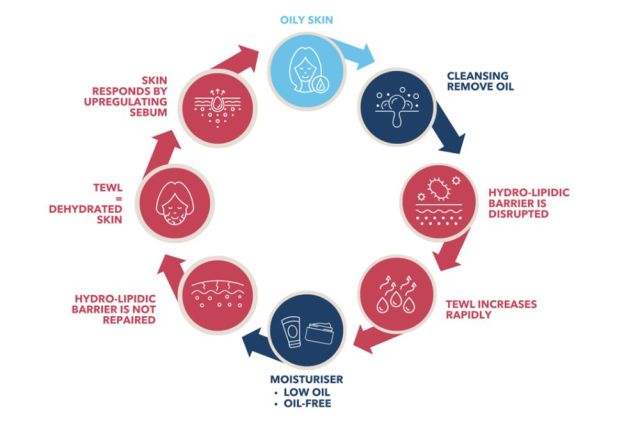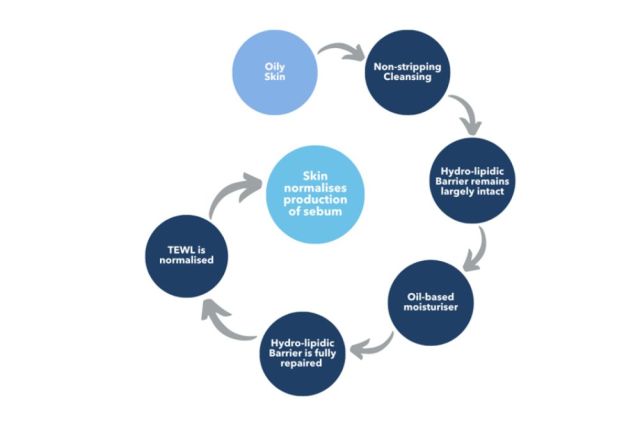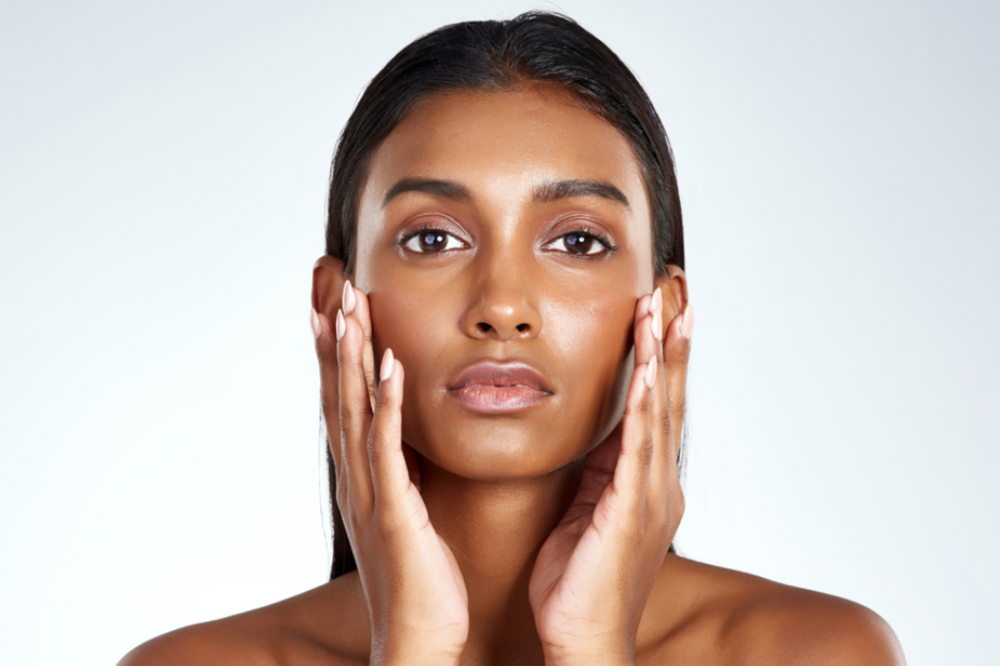By Paul Fister, B.Bus (Mktg), Dip. Form. Chem., Member ASCC
With oily skin, it is easy to make the mistake of treating the symptom rather than the cause. Here is how I first learned this.
Michelle joined OmniDerm in the early days of our business. She came to us from a famous competitor, a water-based skincare range. She loved their products and would say: “Nothing else will ever touch my skin!”.
Michelle was a model employee. Always on time. Always immaculately dressed and made up. Unfortunately, every day, by lunchtime, her cheeks and forehead would glisten with excess sebum.
After a couple of months of listening to us explain our philosophy about oil-based creams to prospective customers Michelle decided to try one of our generous samples. Five days later her skin was not getting oily anymore. What happened?
Before we go further, I need to state two facts that are relevant to this discussion:
- Oil-based creams offer superior and longer-lasting hydration compared to water-based creams. They have a superior ability to repair and maintain the skin’s hydro-lipidic barrier. This was proven in clinical trials in Germany and in Italy.¹
- Carl R. Thornfeldt, MD, states: When the TEWL increases by as little as 1%, physiologic signals induce barrier repair by initially upregulating lipid synthesis.² (Note: TEWL = Trans-Epidermal Water Loss)
Nobody wants skin with an oily shine. The instinctive reaction is to strip away the pesky oils, cover the shine with makeup, blot up the oil with absorbent materials, to apply oil-free moisturisers or serums. All these steps are typically “treating the symptom”. They miss the cause. How is that? Let’s analyse it.
What happens when we are faced with oily skin? The old adage applies: to every action there is a reaction. This very much applies to how we treat our skin. Our graphic illustrates the process.

Now let’s pull this apart. Cleansers for oily skin are often formulated to be highly effective in removing oils. This applies even more so if our thinking is that ‘sebum serves no known function’ – we might as well strip sebum out of the skin.³ As a result the skin’s hydro-lipidic barrier is seriously impaired, some would say ‘destroyed’. Now TEWL (Trans-Epidermal Water Loss) increases rapidly, leading to dehydration of the skin.
Next, we are looking to apply our moisturiser. Recommendations vary significantly. Some recommend not to apply a moisturiser at all. Others recommend a serum, a light moisturiser low in oil, or an oil-free moisturiser. Neither of these products are effective at repairing the hydro-lipidic barrier. TEWL continues at increased levels, and dehydration of the skin is getting worse.
Here is a comment from Carl R. Thornfeldt, MD:
Many of the very light moisturising products are actually very destructive to the stratum corneum barrier because they are deficient in the total amount of lipid needed and often throw off the normal lipid ratio, thus damaging barrier integrity.4
As mentioned in point 2 above, Dr. Thornfeldt identified that the skin reacts to moisture loss by upregulating its production of lipids. Why does it do this? We refer back to our article on Skin Hydration: for our body, loss of moisture from the skin is literally a survival issue. It reacts immediately to stave off the danger.
To recap: we have removed the oils with a cleanser. We have applied a cream low in oils or possibly oil-free. The skin barrier is weakened, and the skin experiences increased TEWL. It responds by upregulating sebum. The result: within a few hours the skin is oily again. And because we have not identified nor treated the true cause we are annoyed and reach for that cleanser again.
So, what happened to Michelle?
She had oily skin. She used our gentle cleanser that is formulated to remove excess oil with minimal disturbance to the skin’s hydro-lipidic barrier. She then applied our oil-based moisturiser.
Oil-based moisturisers are formulated to be ‘biomimetic’. They quickly repair the skin’s hydro-lipidic barrier. They are scientifically proven to slow moisture loss from the skin to healthy, natural levels. In fact, you can feel the difference literally as soon as you apply this type of cream to your skin. For a discussion on the skin’s hydro-lipidic barrier, see our article on Skin Hydration.
Following the application of our oil-based cream, TEWL from Michelle’s skin was reduced immediately to natural, healthy levels. The danger of dehydration is controlled; the skin’s ‘physiologic upregulation button’ is not pushed. As a result, her skin normalised the production of sebum within five days. Her skin was not getting oily any longer. Here is the corresponding graphic:

Fast forward two years. A prospective supplier sent us an advance sample of a water-based cream that was specifically formulated for oily skin. Michelle did a test with this new cream. Within four days her skin was getting oily again.
I have been writing articles about this since the year 2000. In 2004 the founder of a well-known Australian skincare brand did a presentation on acne treatments at an event on the Gold Coast. He had read my articles and knew I was in the audience. He started his presentation, looking directly at me, with the following comment:
“This business about oily skin and oil-based creams doesn’t work. The skin has no feedback mechanism. It doesn’t know whether you apply a water-based cream or an oil-based one.”
I do agree that the skin may not register the difference between a water-based cream and an oil-based cream. However, as explained above, it will react quickly if the cream does not provide adequate protection against excessive TEWL. The reason we often don’t recognise the causal relationship is because the reaction is one step removed from the cause.
If you are faced with a skin concern, we suggest you always look beyond the symptom to identify the likely causes. Here are some frequently observed symptoms:
- Redness: it’s okay to apply a calming or camouflaging product – but what caused the redness in the first place?
- Sensitivity: what is the true cause of this condition? We prefer to call it ‘sensitised ‘skin.
- Dull skin, impaired desquamation: you can counteract with ongoing exfoliation but what is the underlying reason for the dullness caused by malfunctioning desquamation?
- Impure skin: a pimple forms when the exit of the sebaceous gland to the surface of the skin is blocked. What is the true cause?
Note: Good Decisions are based on Good Information.
No doubt many will disagree with the information in this article. All texts I have read, whether from Europe or from the USA, recommend the use of low-oil or oil-free moisturisers. Yet our personal experiences and a thorough understanding of the skin’s functions suggest that oil-based moisturisers may not be a bad idea. We have even seen surprising results with acneic skins.
If you have never used an oil-based moisturiser you can not know what well-hydrated skin truly feels like.
For more information, visit www.dr-spiller.com.au.
Dr. Spiller is distributed in Australia by OmniDerm Pty. Ltd
51-53 Tinning Street, Brunswick VIC 3056
T: 03 9645 0200
E: admin@omniderm.com.au
References:
1Skin Slugging: Why is this Trending? – Professional Beauty
2 The New Ideal in Skin Health: Separating Fact from Fiction, Carl R. Thornfeldt, MD and Krista Bourne, LE, Allured Business Media, 336 Gundersen Drive Suite A, Caro Stream, IL 60188 USA, ISBN: 978-1-932633-69-6, p. 172
3 Skin Hydration: How Does This Work? – Professional Beauty
4 Carl R. Thornfeldt, MD and Krista Bourne, op. cit, p.172.
Read the current issue of our digital magazine here:
- For more news and updates, subscribe to our weekly newsletter
- Follow us on Instagram
- Like us on Facebook
- Join Australia’s largest network of beauty industry professionals on LinkedIn
- Subscribe to our print magazine
Have an idea for a story or want to see a topic covered on our site and in our pages? Get in touch at info@professionalbeauty.com.au.

